Our AAN powered UrS4s and UrS6s have a fairly simple turbo to intake system, as shown here:
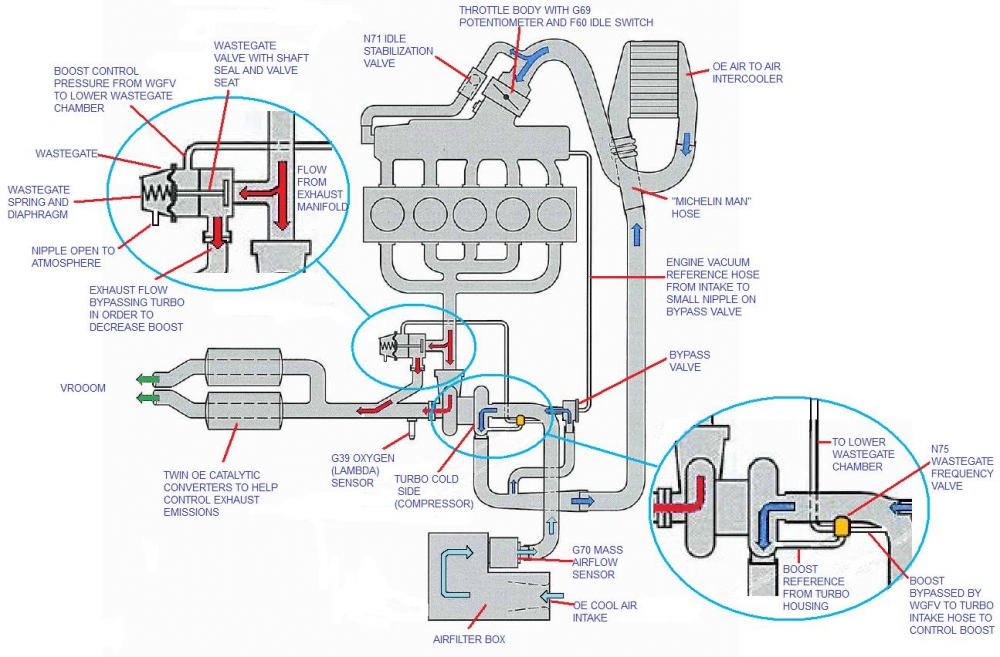
However, there are at least six other systems that are connected to the turbo system. These other systems include:
1. The bypass valve system,
2. The N80 Evaporative Emissions Control System,
3. The Crankcase Ventilation system,
4. The N75 Waste Gate Frequency Valve (WGFV) system.
5. The Fuel Pressure Regulating Valve system.
6. The N71 Idle Stabilization Valve (ISV)
There are rubber and metal components of all four systems that have and/or will fail at some point, allowing boost pressure (and air) to go missing. This results in poor performance and, sometimes, a check engine code because the ECU recognizes that less air than expected showed up at the engine.
The purpose of this post is to identify the most likely causes of the boost/air leak and how to find them.
The possible sources of a boost leak, based on highest to lowest probablilty, include the following:
1. "Michelin Man" hose between the cross-over tube and the inlet to the side-mount OE. This hose is corrugated and made of rubber. Oily vapours tend to condense inside the hose and lay in the valleys of the corrugations. This rots and weakens the rubber until the point where it splits, causing a massive boost leak. At that point you really don't need a boost leak test. This post is intended to help you find the leak before it is massive so you can replace the hose before it fails catastrophically.
Here's a photo from AudiHeel(GoHeels) showing the way the rubber rots and eventually splits:
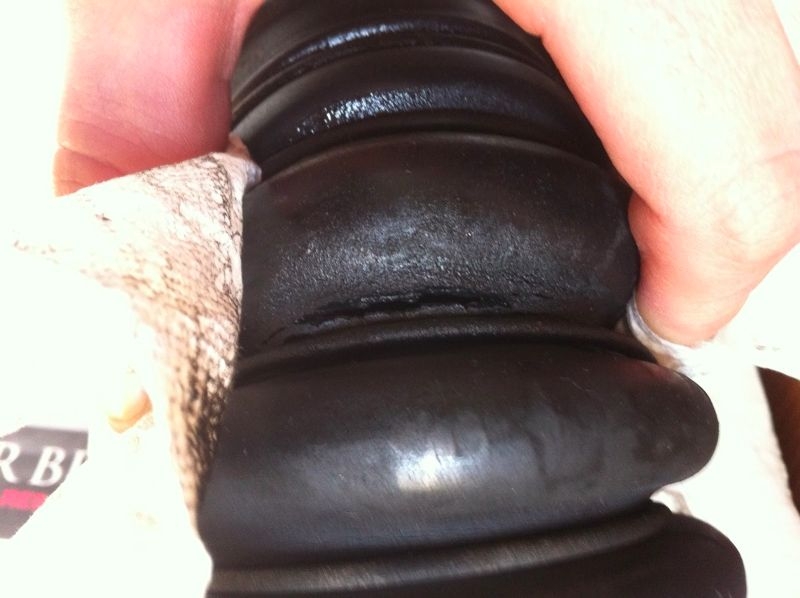
Here is another "Michelin Man" hose that split despite being wrapped with a silicon tape (Not a Samco, OE rubber with silicon tape wrap - lasted 1 year with MTM 1+):
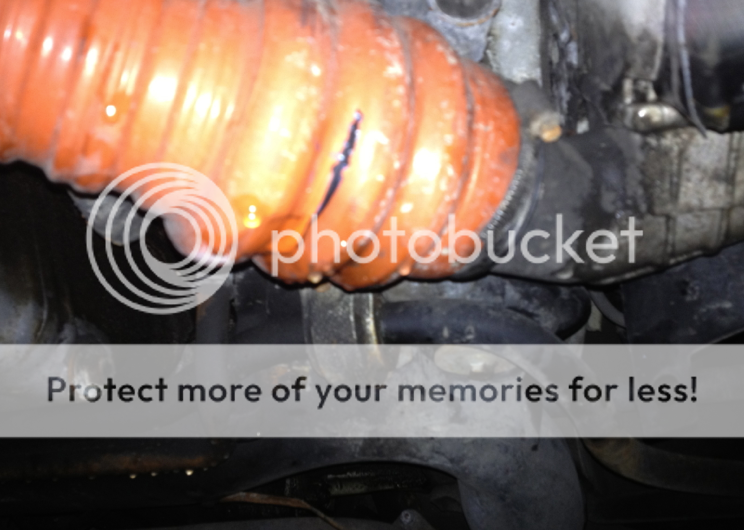
2. The "Tee" hose under the intake manifold where the N80 Evaporative Emissions Control System and Crankcase Ventilation system connect into the intake manifold. Here is one example of one such "Tee" hose with a split, upstream of the PCV system one-way valve.
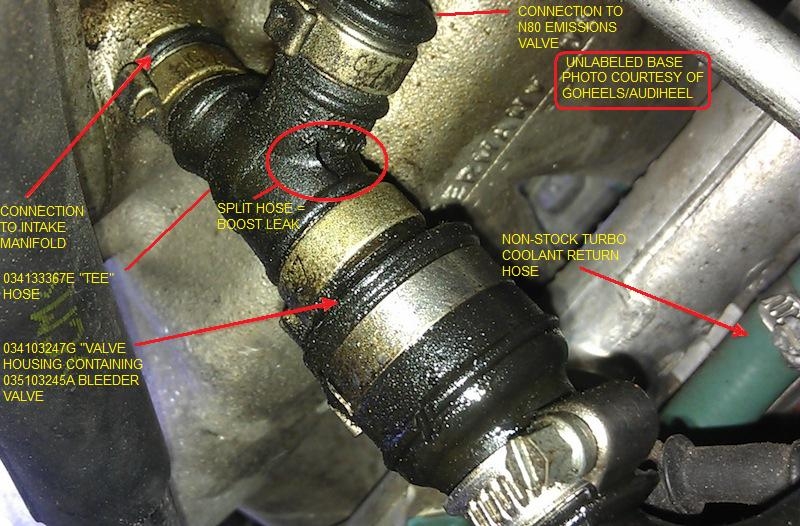
3. Cross-over pipe - at least the UrS6 plastic ones


Here is a metal cross-over pipe with F4 Silicon tape-wrapped OE hoses (by Kingtr). (Michelin Man lasted one year with MTM 1+)

4. The plastic-ended UrS6 side-mount intercooler
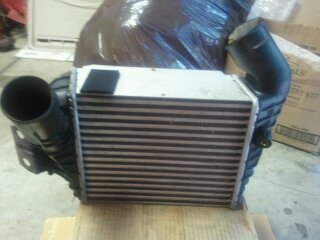
[INSERT BETTER PHOTO HERE - the above is just a tide-me-over]
5. The other hoses between the turbo and the throttle body, including those cut by over-zealous clamp tightening.
Like this one (turbo to cross-over tube and BPV) that held until 10 psig boost and then would open up and dump boost. At idle it would be closed up again, hidden.
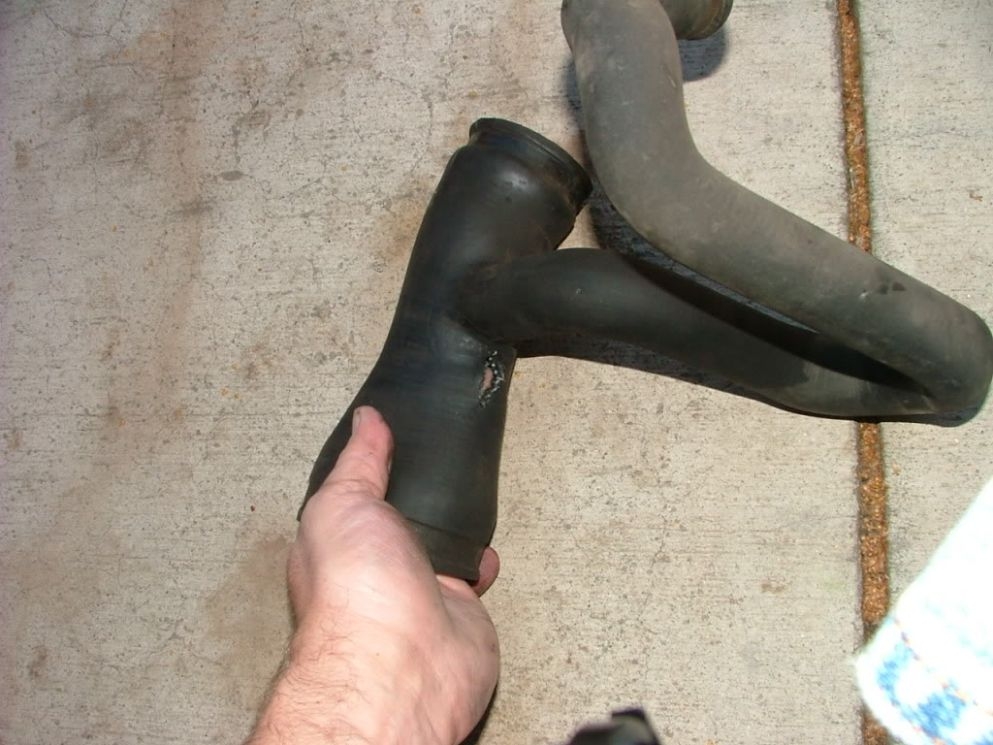
Photo courtesy of Marvin H. (MarvelousS4)."
Thanks Marv.
Here is another example, "Item 7" in the parts diagram below, the 90 deg rubber boot that connects the PCV system flow to the transfer tube that goes through the AAN (and ABY and ADU) cam cover. This one split where the clamp goes and if the one-way bleeder valve has failed the split becomes a boost leak. The blue hose is a $5 Chinese silicone hose that is going to replace Item 7.
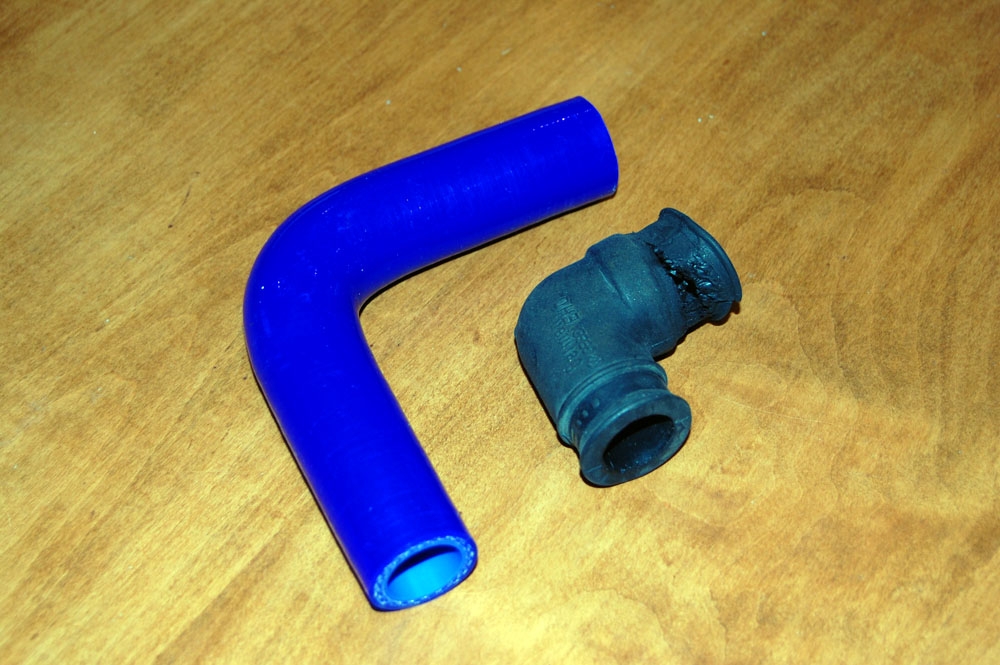
6. Other components of the Crankcase ventilation system, including the one-way bleeder valve and the pressure regulating valve and any and all plastic, metal and rubber piping.

.jpg)
Photos courtesy of Autohauz and ECS Tuning
7. The N71 Idle Stabilization Valve (ISV) (plastic bits crack and leak) and the attendant hoses and pipes between the ISV and the back of the intake manifold.
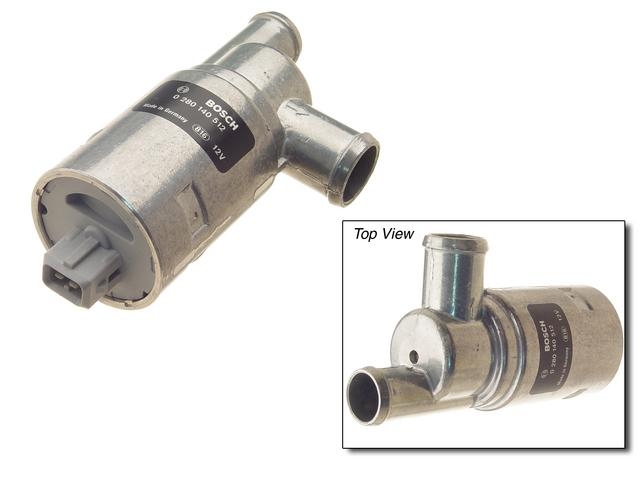
Here is an ISV valve showing leaking during a boost test (happens to be on a 3B or ABY but it is the same exact ISV so be aware that they do/can leak):
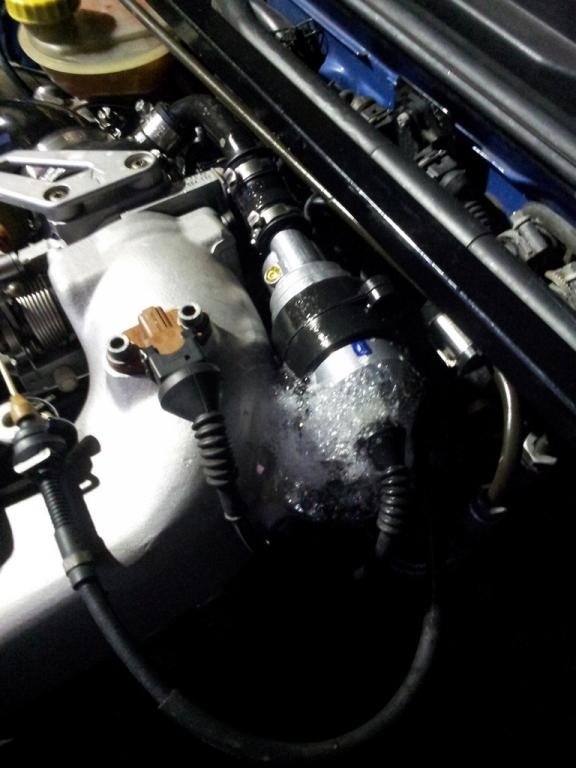
8. The Bypass Valve
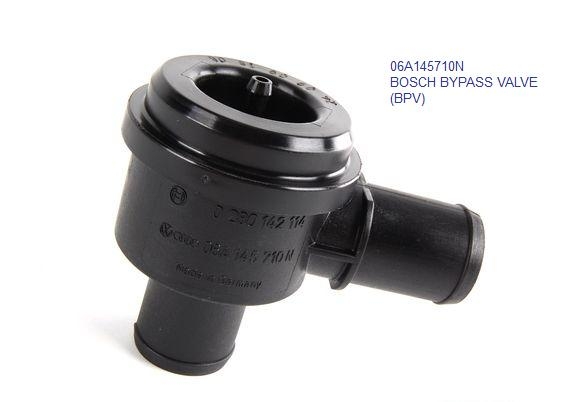
9. The N80 Evaporative Emissions Control System valve
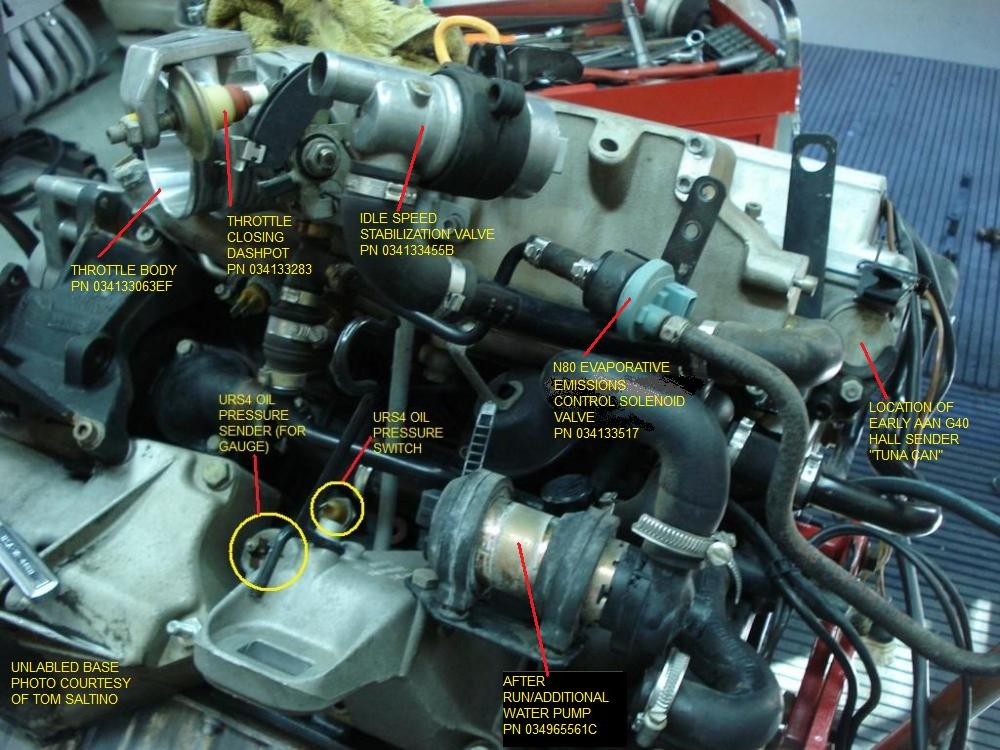
10. The N75 Waste Gate Frequency Valve and its attendant vacuum lines.
11. The vacuum lines between the intake manifold and the Fuel pressure regulator and the Moisture Trap and The G71 Manifold Absolute Pressure (MAP) sensor (in the ECU)
Here are six diagrams that contain the info needed to methodically think through the boost testing procedures and what you are looking for.
The AAN intake tract from air cleaner to throttle body (note labels (A1),(B2), (C1) etc):
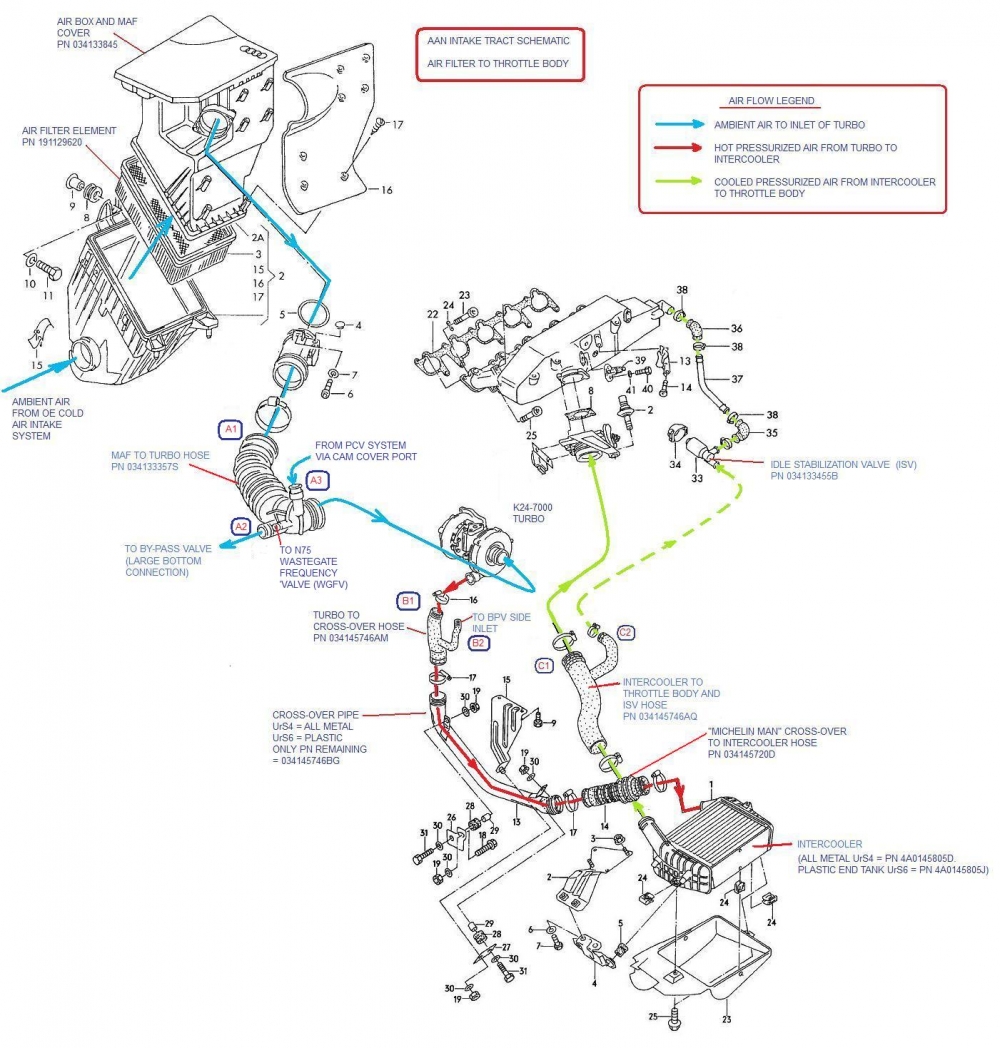
The Crankcase Ventilation system diagram (Note Items 3, 10 and 14 as potential suspects):
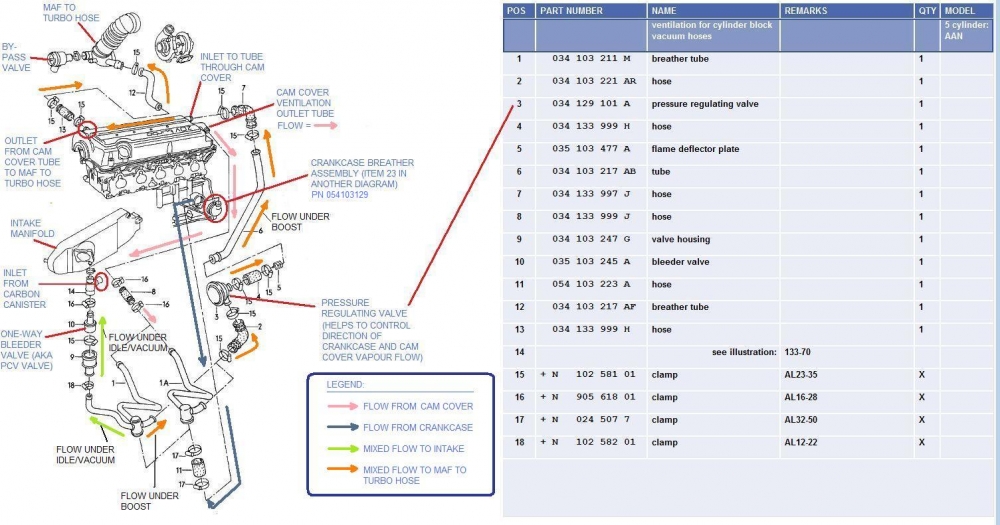
The N80 Evaporative Emissions System diagram (Note Item 1 is the "Tee" hose labeled as Item 14 above):
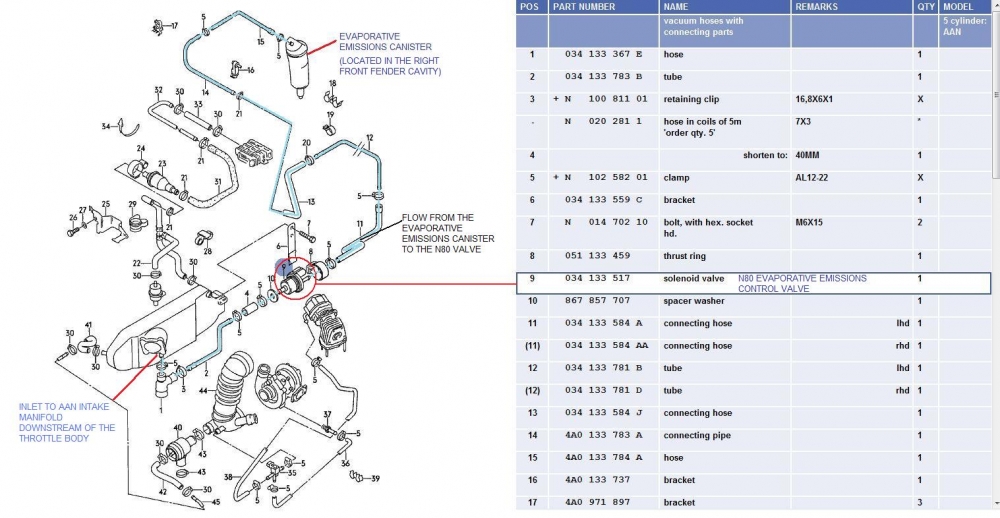
The WGFV and BPV vacuum line diagram
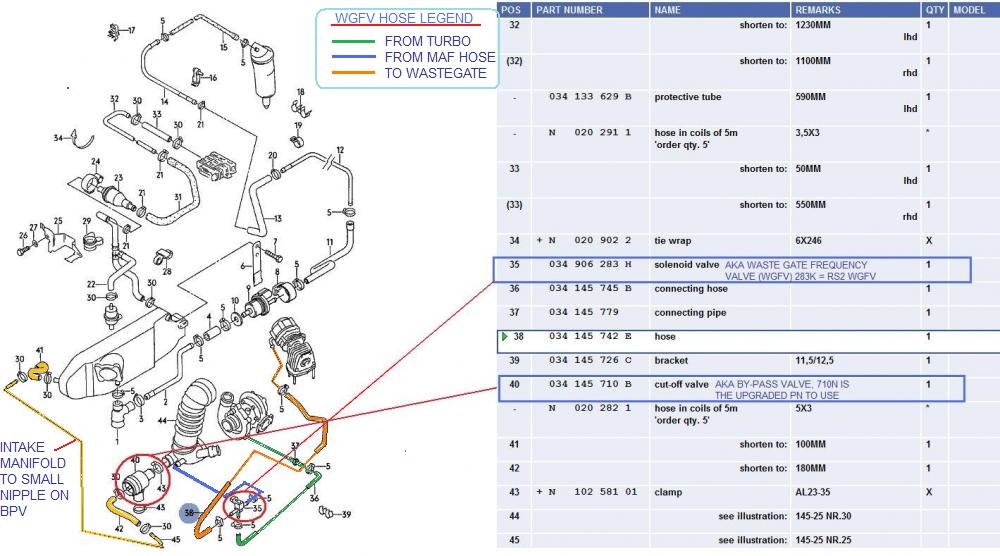
The vacuum/boost lines to the fuel pressure regulator, the moisture trap and the MAP sensor:
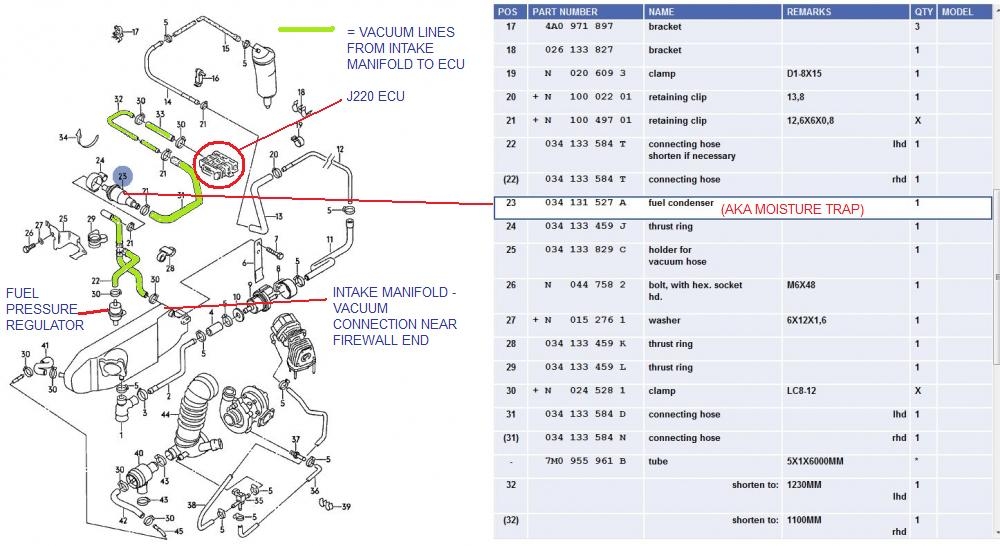
Here is a consolidated drawing

Here is a diagram that shows a boost test that focuses only on the boost hoses and intercooler between the turbo and the throttle body (Option 6 below):
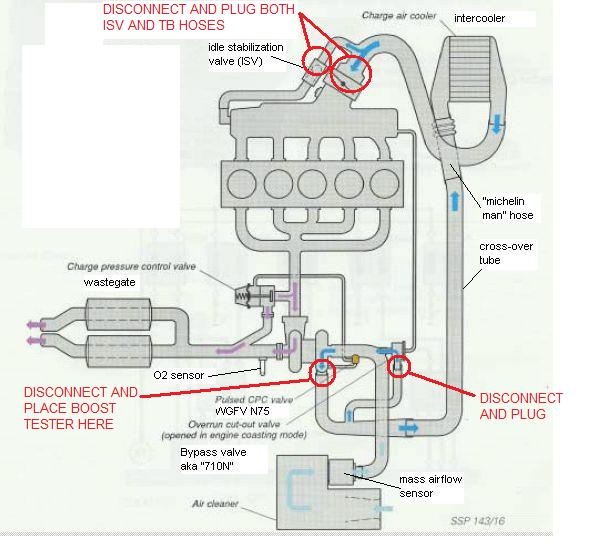
Testing for boost leaks involves introducing controlled pressure, i.e. 10 to 15 psi from an air compressor into a non-running engine, with a pressure testing bung, such as shown in the diagram below and various other hoses plugged off (as appropriate to that test).
Here is an example boost testing cap with a metal air line hose connection (could also be a metal Schrader tire valve) to introduce the air and then monitor with a pressure gauge.
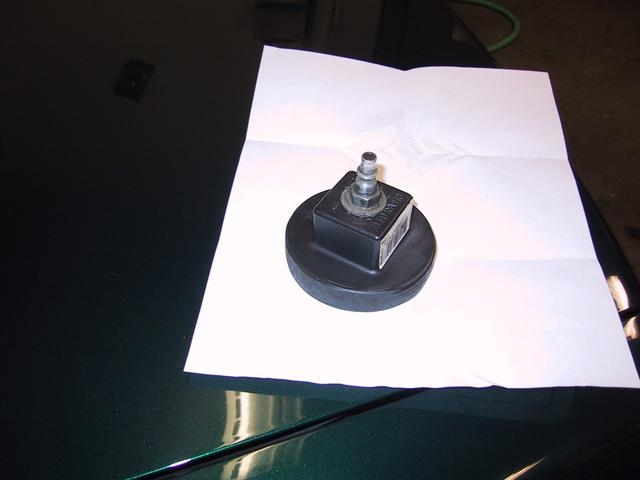
Photo courtesy of 4Driver4 (Tom M.)
Having a spray bottle filled with a very soapy water solution to spray onto the suspect parts (bubbles = leaks) is useful (the leak might be small and it might not produce a noticeable sound)
Here is a table that outlines the various boost testing options based on the above diagrams.
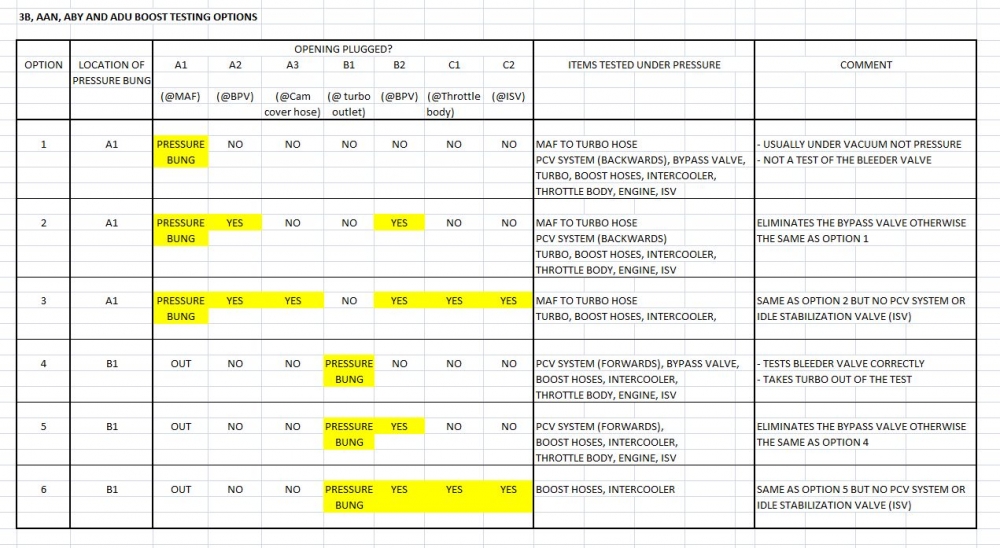
There might still be some minor errors in the above that will be corrected after people make their comments and provide their suggestions.
ADDITIONAL PHOTOS WELCOMED.
Thanks to those who contributed photos and diagrams used in this post.
/The staff at STFA.

However, there are at least six other systems that are connected to the turbo system. These other systems include:
1. The bypass valve system,
2. The N80 Evaporative Emissions Control System,
3. The Crankcase Ventilation system,
4. The N75 Waste Gate Frequency Valve (WGFV) system.
5. The Fuel Pressure Regulating Valve system.
6. The N71 Idle Stabilization Valve (ISV)
There are rubber and metal components of all four systems that have and/or will fail at some point, allowing boost pressure (and air) to go missing. This results in poor performance and, sometimes, a check engine code because the ECU recognizes that less air than expected showed up at the engine.
The purpose of this post is to identify the most likely causes of the boost/air leak and how to find them.
The possible sources of a boost leak, based on highest to lowest probablilty, include the following:
1. "Michelin Man" hose between the cross-over tube and the inlet to the side-mount OE. This hose is corrugated and made of rubber. Oily vapours tend to condense inside the hose and lay in the valleys of the corrugations. This rots and weakens the rubber until the point where it splits, causing a massive boost leak. At that point you really don't need a boost leak test. This post is intended to help you find the leak before it is massive so you can replace the hose before it fails catastrophically.
Here's a photo from AudiHeel(GoHeels) showing the way the rubber rots and eventually splits:

Here is another "Michelin Man" hose that split despite being wrapped with a silicon tape (Not a Samco, OE rubber with silicon tape wrap - lasted 1 year with MTM 1+):

2. The "Tee" hose under the intake manifold where the N80 Evaporative Emissions Control System and Crankcase Ventilation system connect into the intake manifold. Here is one example of one such "Tee" hose with a split, upstream of the PCV system one-way valve.

3. Cross-over pipe - at least the UrS6 plastic ones


Here is a metal cross-over pipe with F4 Silicon tape-wrapped OE hoses (by Kingtr). (Michelin Man lasted one year with MTM 1+)

4. The plastic-ended UrS6 side-mount intercooler

[INSERT BETTER PHOTO HERE - the above is just a tide-me-over]
5. The other hoses between the turbo and the throttle body, including those cut by over-zealous clamp tightening.
Like this one (turbo to cross-over tube and BPV) that held until 10 psig boost and then would open up and dump boost. At idle it would be closed up again, hidden.

Photo courtesy of Marvin H. (MarvelousS4)."
Thanks Marv.
Here is another example, "Item 7" in the parts diagram below, the 90 deg rubber boot that connects the PCV system flow to the transfer tube that goes through the AAN (and ABY and ADU) cam cover. This one split where the clamp goes and if the one-way bleeder valve has failed the split becomes a boost leak. The blue hose is a $5 Chinese silicone hose that is going to replace Item 7.
6. Other components of the Crankcase ventilation system, including the one-way bleeder valve and the pressure regulating valve and any and all plastic, metal and rubber piping.

.jpg)
Photos courtesy of Autohauz and ECS Tuning
7. The N71 Idle Stabilization Valve (ISV) (plastic bits crack and leak) and the attendant hoses and pipes between the ISV and the back of the intake manifold.

Here is an ISV valve showing leaking during a boost test (happens to be on a 3B or ABY but it is the same exact ISV so be aware that they do/can leak):

8. The Bypass Valve

9. The N80 Evaporative Emissions Control System valve

10. The N75 Waste Gate Frequency Valve and its attendant vacuum lines.
11. The vacuum lines between the intake manifold and the Fuel pressure regulator and the Moisture Trap and The G71 Manifold Absolute Pressure (MAP) sensor (in the ECU)
Here are six diagrams that contain the info needed to methodically think through the boost testing procedures and what you are looking for.
The AAN intake tract from air cleaner to throttle body (note labels (A1),(B2), (C1) etc):

The Crankcase Ventilation system diagram (Note Items 3, 10 and 14 as potential suspects):

The N80 Evaporative Emissions System diagram (Note Item 1 is the "Tee" hose labeled as Item 14 above):

The WGFV and BPV vacuum line diagram

The vacuum/boost lines to the fuel pressure regulator, the moisture trap and the MAP sensor:

Here is a consolidated drawing

Here is a diagram that shows a boost test that focuses only on the boost hoses and intercooler between the turbo and the throttle body (Option 6 below):

Testing for boost leaks involves introducing controlled pressure, i.e. 10 to 15 psi from an air compressor into a non-running engine, with a pressure testing bung, such as shown in the diagram below and various other hoses plugged off (as appropriate to that test).
Here is an example boost testing cap with a metal air line hose connection (could also be a metal Schrader tire valve) to introduce the air and then monitor with a pressure gauge.

Photo courtesy of 4Driver4 (Tom M.)
Having a spray bottle filled with a very soapy water solution to spray onto the suspect parts (bubbles = leaks) is useful (the leak might be small and it might not produce a noticeable sound)
Here is a table that outlines the various boost testing options based on the above diagrams.

There might still be some minor errors in the above that will be corrected after people make their comments and provide their suggestions.
ADDITIONAL PHOTOS WELCOMED.
Thanks to those who contributed photos and diagrams used in this post.
/The staff at STFA.






 I digress...
I digress...  Good thing you're not in OZ. Then you'd be "Bluey".
Good thing you're not in OZ. Then you'd be "Bluey".  to do a new diagram similar to the one I did for the S2/RS2 with six different vacuum/boost signal, evaporative emissions, etc. hose circuits.
to do a new diagram similar to the one I did for the S2/RS2 with six different vacuum/boost signal, evaporative emissions, etc. hose circuits.
 Ooo...stay out of the sun or you'll burn to a crisp. (Or try SPF 2000 sunscreen)
Ooo...stay out of the sun or you'll burn to a crisp. (Or try SPF 2000 sunscreen) 
Comment